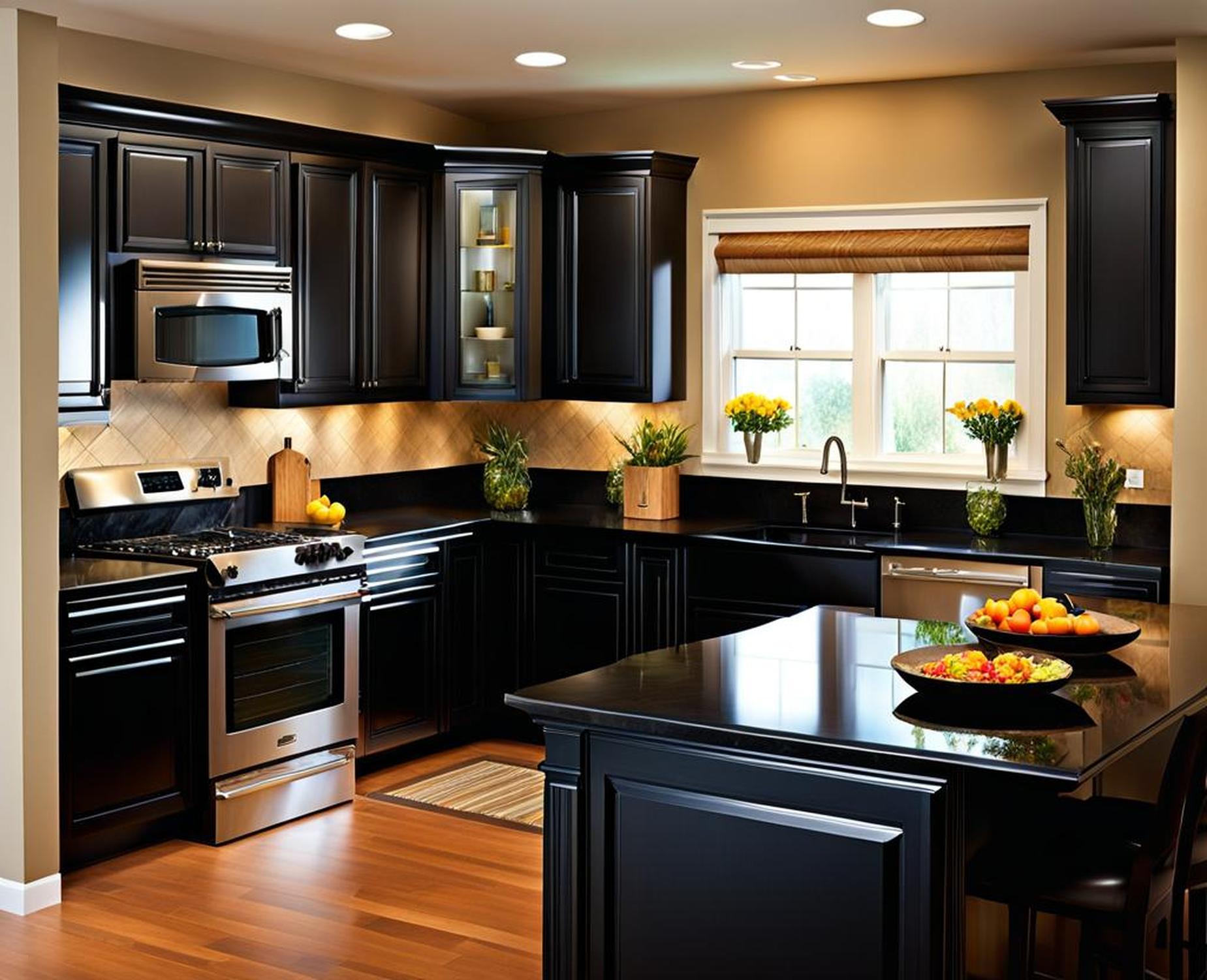Looking to make a bold statement in your kitchen? Consider embracing the dark side with striking black countertops. From sleek polished granite to the subtle allure of matte soapstone, black counters can transform your culinary space into a moody, elegant oasis.
In recent years, black finishes have been gaining popularity across interior design. Black countertops are especially coveted for adding dimension and sophistication to any kitchen. Keep reading as we explore the dramatic appeal of black counters, review the most popular materials, and cover key design considerations for integrating them into your home.

The Allure and Drama of Black Countertops
What makes black counters stand out is their richness and depth. The dark hue brings vibrancy to kitchens, creating an ambiance of refinement. It provides a neutral backdrop that allows other elements to pop.
Polished black granite presents a glossy, mirrored surface. The high sheen emphasizes the natural veining and patterns in the stone. Soapstone, on the other hand, has an inherently matte finish. This softer contrast can provide an earthy, rustic feel.
While some prefer black due to its elegance, the color also offers practical advantages. Darker counters hide fingerprints, water spots, and other minor marks better than light-colored materials. They coordinate well with many cabinets, flooring, and wall colors too.
Most Popular Materials for Black Countertops
Granite
Granite is a natural stone prized for its hardness, durability, and longevity. It’s highly resistant to scratches, stains, and heat. However, the mineral makeup varies, so certain granite can be more prone to etching from acidic liquids. Overall, black granite remains an excellent option that pairs nicely with other stones and metals.
Soapstone
Quarried from steatite stone, soapstone is naturally matte due to its talc composition. It’s soft and porous compared to granite, making it less impervious to damage. On the plus side, it’s exceptionally heat-tolerant. Soapstone requires regular sealing to prevent stains. Its lighter veining can lighten over time, developing an antique patina.
Quartz
Engineered quartz blends ground quartz aggregate with pigments and resin. It offers a uniform appearance with less variation than natural stone. Quartz is non-porous, making it very low maintenance. It rarely needs sealing and resists scratches, stains, and heat. The composition makes it neutral in pH, so it’s not prone to etching. Durability comes at a tradeoff, as patches or repairs may be more noticeable.
| Material | Pros | Cons |
|---|---|---|
| Granite | Durable, scratch-resistant | Can etch from acids |
| Soapstone | Heat-tolerant, matte finish | Softer, stains easier |
| Quartz | Low maintenance, neutral pH | Repairs are visible |
Design Considerations for Black Kitchen Countertops
Cabinetry Selection
With black counters as your foundation, the cabinetry finish plays an integral role. White or light gray cabinets provide bold contrast. Soft beiges and grays also coordinate nicely. For a moodier aesthetic, opt for espresso-stained wood or lacquered cabinets in a deep navy or charcoal.
Regardless of color, remember to cohesively tie the cabinets to the entire kitchen scheme. For traditional designs, Shaker-style cabinetry balances sleek lines with the rugged texture of real wood grain.
Backsplash Pairings
The backsplash presents another opportunity to complement black countertops. White subway tile is a popular option, brightening up the space while allowing the dramatic counters to take center stage. For a contemporary edge, concrete, metal, or glass backsplashes introduce eye-catching shine.
Natural materials like marble, travertine, or limestone offer soft, organic contrast. Take care to seal any porous backsplash properly though. A dark-grouted neutral tile can also provide subtle textural interest against polished granite.
Additional Elements
Beyond cabinetry and backsplashes, other decorative aspects impact the overall composition. Consider incorporating metallic accents through hardware, fixtures, or appliances. The sheen of brass, copper, or stainless steel pops alluringly against dark counters.
Playing with different textures also adds intrigue. For instance, pairing matte soapstone with a textured tile backsplash. Or, choose a polished granite counterbalanced by nubby, textured fabric curtains.
Lastly, vibrant pops of color enliven the space. Vivid red bar stools, a colorful mosaic tile insert, or a bright patterned area rug leads the eye through the monochromic palette.
Caring for Your Black Countertops
To keep black counters looking their best, pay heed to the material-specific care guidelines. Granite and soapstone need yearly sealing to prevent stains and damage in porous areas. Quartz rarely requires sealing. For regular upkeep, use a pH-neutral cleaner and avoid harsh chemicals that can strip sealants.
Although durable, black counters still need some gentle handling. Trivets and cutting boards help safeguard against scratches and scorch marks. Stay attentive when working with potential staining agents like wine, coffee, or brightly colored liquids. Any spills should be wiped up quickly before they set.
Black countertops unequivocally imbue kitchens with mystique and sophistication. By reviewing the unique qualities of granite, soapstone, and quartz, analyzing ideal color pairings, and incorporating metallic and textural accents, you can thoughtfully design your ideal moody sanctum. Embrace the dark side and take your kitchen to new depths with striking black countertops.
